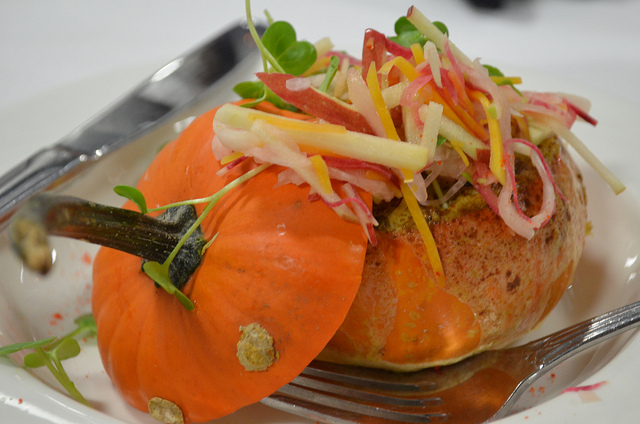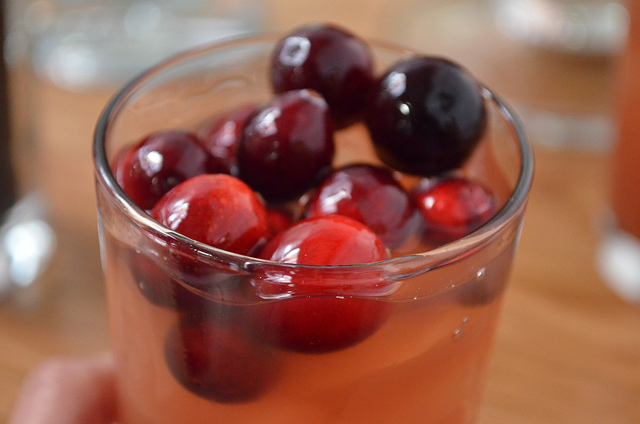Thanksgiving questions and answers 2012
By Louisa Chu

Thanksgiving questions and answers 2012
By Louisa Chu
You asked, I answer your Thanksgiving questions below — and today, live on The Morning Shift with Tony Sarabia. We’re joined by guest Steven Rinella: hunter, author and host of MeatEater on the Sportsman Channel!
Q: There are millions of vegetarians/vegans who are lucky if they can eat one side dish or two. We would love some ideas. Fruit salad and green bean casserole for dinner any time of the year sucks.
A: Really? I love green bean casserole and fruit salad, because they don’t have to suck. When I’ve made green beans for Thanksgiving, it’s not the classic casserole, but with the same flavors. I stir-fry green beans in butter, leaving them crisp, with thinly sliced onions and wild mushrooms, then smother it all in Béchamel. Alton Brown’s recipe for Best Ever Green Bean Casserole looks good — without the frozen beans, and cans of cream of mushroom soup and fried onions — but substitute his chicken broth with vegetable broth. For fruit salad, I mix fresh, cooked and preserved fruit — from poached cranberries, apples, and pears, to persimmons and figs too — usually splashed with an herb-infused, liqueur-spiked, simple syrup. For some beautiful inspiration, see Heidi Swanson’s 101 Cookbooks for recent Thanksgiving ideas and previous vegan and vegetarian recipes.
Q: I saw something recently, I think in the New York Times, about how butternut squash is actually the way to go if you want to make homemade, not from a can, pumpkin pie — like pumpkin actually isn’t good, no matter how hard you try to sweeten it or get it to be the right texture. True or not true?
A: Melissa Clark did indeed write in the NYT “Diner’s Journal” that butternut squash is the best kind of pumpkin/winter squash for pumpkin pie. Clark tested nine varieties: acorn, blue hubbard, butternut, carnival, cheese pumpkin, delicata, kabocha, sugar pumpkin and spaghetti squash. “Deep and richly flavored, sweet, with relatively smooth flesh that is easy to purée,” she wrote in her testing notes. But Bang Bang Pie Shop uses sugar pumpkins and their pies are great — sweet enough, with absolutely the right texture, plus roasted pumpkin seeds. With any natural ingredient there will be variations.
Q: Talk about the do’s and don’ts of stuffing baked inside the turkey. I’ve read conflicting things about not doing it because you can get salmonella, or to put it in there once the turkey reaches a certain temperature, etc.
A: Do: Remember the magic number, according to the USDA’s Food Safety and Inspection Service — 165 °F. That’s what the agency says should be the minimum internal temperature. Do: Check out the USDA’s “Stuffing and Food Safety” fact sheet. Don’t: Worry. It’s all in there.
Q: We’ve been hosting Thanksgiving for the last few years, and we always brine the turkey in salt water flavored with ginger and allspice. I saw a recipe the other day that called for salting the turkey for 24 hours. That’s a new one for me. What’s the difference? I mean, I know one of them is a water soak and the other one is not, but what happens from salting that’s different from brining?
A: Salting, or dry-brining, is the new wet-brining. “When you salt a turkey (or chicken) breast, meat juices are initially drawn out through the process of osmosis,” writes J. Kenji López-Alt in “The Food Lab: The Truth About Brining Turkey” on Serious Eats. “As the salt dissolves in these juices, it forms what amounts to a very concentrated brine, which then allows it to break down muscle proteins.” As a result, López-Alt says he never brines, ever. Michael Ruhlman no longer brines his turkey either, saying it’s not worth the hassle, given the busyness of prep.
Q: My family gets a smoked turkey from a BBQ joint in Evanston every year. Any way to replicate this deliciousness as a home cook?
A: Smoking your own in an outdoor smoker is not the answer you’re looking for, I’m guessing. Steven Raichlen actually adapted two of his indoor smoked turkey recipes for an article in the Times, using a stovetop smoker like Camerons or a wok. You can find both recipes in his book Indoor! Grilling.
Q: Turkey doesn’t really thrill me. I could easily have an all-sides meal. Any turkey alternatives that won’t completely veer from tradition?
A: Depends on your tradition, but traditional turkey alternatives include ham, duck, goose, Dungeness crab and especially venison. The Wampanoag brought five deer to the 1621 Plymouth feast that’s considered the historic model for our modern Thanksgiving.
Q: How many turkeys get killed on Thanksgiving?
A: 46 million is the number widely reported, but that’s probably not accurate, according a Wall Street Journal post in 2009. “David Harvey, a poultry and fish-farming analyst with the USDA’s Economic Research Service, says it would be difficult to come up with a precise Thanksgiving turkey tally,” the WSJ reported then.
Q: Does it make a difference if you get a male or female turkey? I heard the females are more tender.
A: No, it doesn’t really matter, and you’re probably getting a female turkey anyway, as most turkeys are female, according to this Marketplace story last year. The University of Illinois Extension Turkey FAQs says “age not gender is the determining factor for tenderness and all commercial turkeys are young and tender.”


